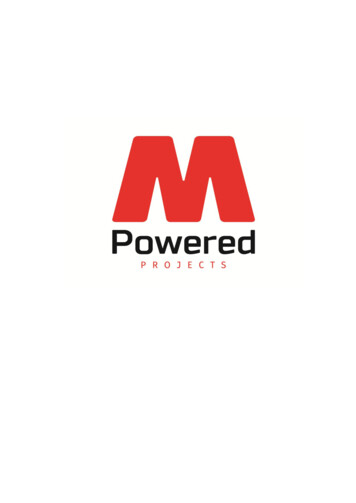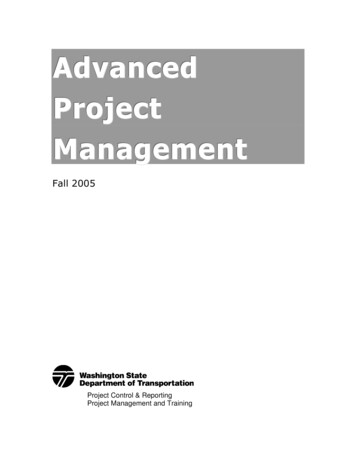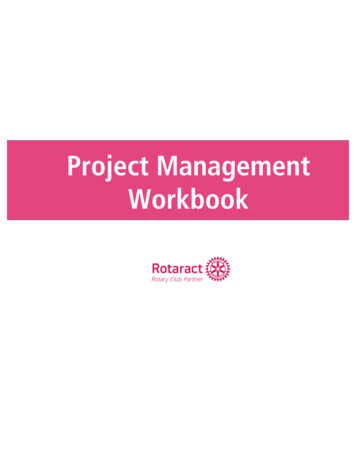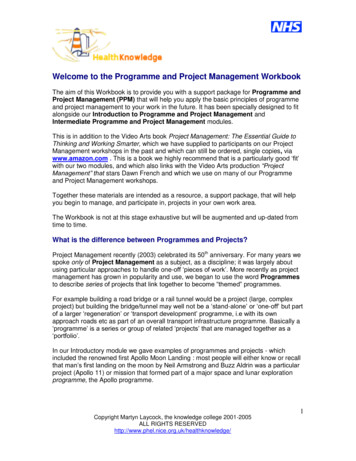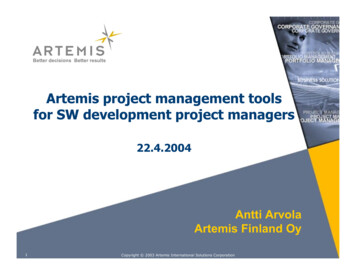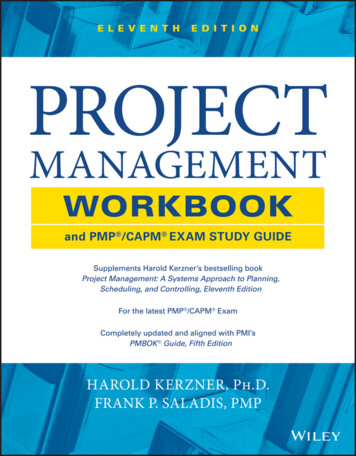
Transcription
Project Management Workbookand PMP /CAPM Exam StudyGuide
Project Management Workbookand PMP /CAPM Exam StudyGuideEleventh EditionHarold Kerzner, Ph.D.Frank P. Saladis, PMP
Cover image: iStockphoto/xiaoke maCover design: John Wiley & Sons, Inc.This book is printed on acid-free paper.Copyright 2013 by John Wiley & Sons, Inc. All rights reservedPublished by John Wiley & Sons, Inc., Hoboken, New JerseyPublished simultaneously in CanadaNo part of this publication may be reproduced, stored in a retrieval system, or transmitted in anyform or by any means, electronic, mechanical, photocopying, recording, scanning, or otherwise,except as permitted under Section 107 or 108 of the 1976 United States Copyright Act, without eitherthe prior written permission of the Publisher, or authorization through payment of the appropriateper-copy fee to the Copyright Clearance Center, 222 Rosewood Drive, Danvers, MA 01923, (978)750-8400, fax (978) 646-8600, or on the web at www.copyright.com. Requests to the Publisher forpermission should be addressed to the Permissions Department, John Wiley & Sons, Inc., 111 RiverStreet, Hoboken, NJ 07030, (201) 748-6011, fax (201) 748-6008, or online atwww.wiley.com/go/permissions.Limit of Liability/Disclaimer of Warranty: While the publisher and author have used their bestefforts in preparing this book, they make no representations or warranties with the respect to theaccuracy or completeness of the contents of this book and specifically disclaim any implied warrantiesof merchantability or fitness for a particular purpose. No warranty may be created or extended bysales representatives or written sales materials. The advice and strategies contained herein may not besuitable for your situation. You should consult with a professional where appropriate. Neither thepublisher nor the author shall be liable for damages arising here from.For general information about our other products and services, please contact our Customer CareDepartment within the United States at (800) 762-2974, outside the United States at (317) 572-3993or fax (317) 572-4002.Wiley publishes in a variety of print and electronic formats and by print-on-demand. Some materialincluded with standard print versions of this book may not be included in e-books or in print-ondemand. If this book refers to media such as a CD or DVD that is not included in the version youpurchased, you may download this material at http://booksupport.wiley.com. For more informationabout Wiley products, visit www.wiley.com.Library of Congress Cataloging-in-Publication Data:Kerzner, Harold.Project management workbook and PMP/CAPM exam study guide / Harold Kerzner, Ph.D., Frank P.Saladis, PMP.—Eleventh edition.pages cmIncludes index.ISBN 978-1-118-55253-7 (pbk.); ISBN 978-1-118-74086-6 (ebk); ISBN 978-1-118-74098-9 (ebk)1. Project management—Examinations—Study guides. 2. Project management—Problems,exercises, etc. I. Saladis, Frank P. II. Title.HD69.P75K493 2013658.4′04076—dc232013013966Printed in the United States of America10 9 8 7 6 5 4 3 2 1
CONTENTSPrefacevii1. Project Management Overview12. Project Management Growth: Concepts and Definitions173. Organizational Structures314. Organizing and Staffing the Project Office and Team415. Management Functions596. Management of Your Time and Stress817. Conflicts958. Special Topics1119. The Variables for Success12710. Working with Executives14311. Planning15512. Network Scheduling Techniques18313. Project Graphics20514. Pricing and Estimating21515. Cost Control23316. Trade-off Analysis25317. Risk Management26318. Learning Curves28119. Contract Management29320. Quality Management31721. Modern Developments in Project Management33322. Situational Exercises34123. Project Management Crossword Puzzles37124. PMP and CAPM Exam Review40525. Challenging and Engaging Questions and Exercises489v
PREFACEThe purpose of this workbook is to provide students of projectmanagement with meaningful exercises and homework problems that willenhance the knowledge of the subjects included in the textbook ProjectManagement: A Systems Approach to Planning, Scheduling, and Controlling,Eleventh Edition by Harold Kerzner.The material in this workbook is directly related to the subject andknowledge areas associated with the Project Management Institute ProjectManagement Professional PMP Exam and the Certified Associate ProjectManager CAPM Exam and will provide a sound framework for exampreparation.The workbook is designed to engage the student in activities that willprovide practical application of the concepts of project management asdescribed in the textbook and in the PMI Guide to Project Management Bodyof Knowledge (PMBOK Guide)—Fifth Edition.Included in this workbook are topic specific glossaries, common projectterms and acronyms, knowledge area summaries, examples of typical projectmanagement mathematical formulas and equations, key project terms andenjoyable crossword puzzles. The workbook also includes PMP Exam studytips, situational exercises, and sample questions designed to simulate the typeof questions that may be encountered on the actual PMP exam.We hope you will find this book enjoyable and educational.vii
Project Management Workbookand PMP /CAPM Exam StudyGuide
Chapter OnePROJECT MANAGEMENT OVERVIEWProject management is not a new concept. It has been practiced for hundreds, eventhousands of years. Any undertaking, large or small, requires a goal, a set of objectives,a plan, coordination, the management of resources, and the ability to manage change.Additionally, every project requires leadership. Project managers work with teams and avariety of stakeholders and must develop the skills to balance the expectations anddemands of each stakeholder.Today, project management has become a very formal methodology, and manyorganizations have adopted a “management by projects” approach. Some organizationshave established Project Management Offices (PMOs) to assist them in developingstandards for managing projects and processes to ensure that these standards arefollowed. As the project management discipline continues to evolve, organizations aroundthe world are experiencing the benefits of project management. These benefits includebetter scheduling of resources, improved estimating, higher quality, early identification ofissues and problems, and more effective measurement processes to assess success.Projects are defined as temporary endeavors with specific start and end dates, and theyare initiated to provide or produce a unique product or service. Project management isthe application of knowledge skills, tools, and techniques to project activities to meetproject objectives. Effective project management is accomplished through theapplication and integration of project management processes that will assist in theinitiation, planning, execution, monitoring, controlling, and closing of a project. Theseprocesses also apply to the management of each phase of a project. A project manageris assigned to a project and becomes accountable for the success of the project througheffective management techniques, coordination between functional organizations, andthe ability to apply the appropriate amount of managerial and cross-organizationalsupport and guidance as the project is executed.Glossary of terms Key project management terms and definitions to reviewand remember. The disciple of project management includes a lexicon that iswidely used in most industries and it is beneficial to learn the “language” of theprofessional project manager.Deliverable A tangible, verifiable work output. Project work will generally producemultiple deliverables that will comprise the final project deliverable.1
2CHAPTER ONEFunctional Manager Generally, the manager who “owns” or supervises the resourcesthat will be assigned to project activities. Functional managers are considered to be thetechnical experts and usually provide information about resource requirements, taskduration, schedule development and cost estimates. Project managers engage theassistance of functional managers (also known as line managers) to develop the projectplan and subsidiary project plans.Non-Project Driven Generally, these organizations do not have a project methodologyin place, are not organized around the delivery of projects, and are arranged in afunctional, organizational structure. Work is generally associated with manufacturing andproduction lines. Projects are established as needed to improve or support functional linesand activities or organizational changes.Program A group of related projects managed in a coordinated way to obtain benefitsand control not available from managing them separately. Generally, projects in a programare interrelated.Project A temporary endeavor undertaken to create a unique product, service, or result.A project has a specific objective, defined start and end dates, and funding limitations.Projects consume resources including human (labor), equipment and materials. A projectis generally multifunctional or cross-organizational in nature.Project Driven Organization Also known as “project based.” In these organizations allwork is characterized through projects. Projects are arranged as separate cost centers andthe sum of all project work is associated with organizational goals and strategic objectives.Project Management Application of knowledge skills, tools, and techniques to projectactivities to meet project requirements. Project management involves the utilization of the5 major process groups: initiation, project planning, executing, monitoring and controlling,and closing. These processes are applied to each project phase and enable the projectmanager to effectively integrate the 10 project management knowledge areas described inthe Guide to the Project Management Body of Knowledge developed by the ProjectManagement Institute or PMI .Project Sponsor Generally, described as the person or organization that authorizes theproject and provides the financial resources required to plan, execute, and deliver theproject objectives.Triple Constraint A framework for evaluating the effects of changes to the competingproject demands of Time (schedule), Cost (budget), and Scope (specifications) usuallydepicted as a triangle. Specifically, the Triple constraint emphasizes that a change to anyone side or element will have an effect on the other elements. The Triple Constraint wasconsidered to display the key factors that define project success. Today, project success isdefined using several success factors including quality, value added, and fitness for use.These factors may be referred to as competing constraints or competing demands.Activities, Questions, and ExercisesRefer to Chapter One of Project Management: A Systems Approach to Planning,Scheduling, and Controlling (11th Edition) for supporting information. Review each of thefollowing questions or exercises and provide the answers in the space provided.1. Dr. Kerzner’s 16 Points to Project Management Maturity1. Adopt a project management methodology and use it consistently.
PROJECT MANAGEMENT OVERVIEW32. Implement a philosophy that drives the company toward project managementmaturity and communicate it to everyone.3. Commit to developing effective plans at the beginning of each project.4. Minimize scope changes by committing to realistic objectives.5. Recognize that cost and schedule management are inseparable.6. Select the right person as the project manager.7. Provide executives with project sponsor information, not project managementinformation.8. Strengthen involvement and support of line management.9. Focus on deliverables rather than resources.10. Cultivate effective communications, cooperation, and trust to achieve rapid projectmanagement maturity.11. Share recognition for project success with the entire project team and linemanagement.12. Eliminate nonproductive meetings.13. Focus on identifying and solving problems early, quickly, and cost effectively.14. Measure progress periodically.15. Use project management software as a tool, not as a substitute for effectiveplanning or interpersonal skills.16. Institute an all-employee training program with periodic updates based ondocumented lessons learned.This exercise is intended to provide you with a basis and understanding of the major goalsof an enterprisewide project management methodology and process for improvement. The16 Points to Project Management Maturity are designed to assist an organization inachieving continuously higher levels of project performance by providing a baseline forassessing the current level of project management maturity and then developing steps toenhance existing processes and/or create new processes that will improve overall projectperformance.Exercise: Review Dr. Kerzner’s 16 points to project management maturity andidentify the specific benefits associated with each point. Identify actions thatmay be taken to introduce, implement, or further enhance the value of each ofthe listed points in an organization.Example:1. Adopt a project management methodology and use it consistently.Action: Provide management with supporting information about how project managementcan assist in achieving organizational objectives. Obtain best practices documentation fromcompanies that are actively using project management processes and methodologies andprovide a summary to executive management.
4CHAPTER ONE2. Implement a philosophy that drives the company toward project managementmaturity and communicate it to everyone.3. Commit to developing effective plans at the beginning of each project.4. Minimize scope changes by committing to realistic objectives.5. Recognize that cost and schedule management are inseparable.6. Select the right person as the project manager.7. Provide executives with project sponsor information, not project managementinformation.8. Strengthen involvement and support of the line management.9. F
Project management workbook and PMP/CAPM exam study guide / Harold Kerzner, Ph.D., Frank P. Saladis, PMP.—Eleventh edition. pages cm Includes index. ISBN 978-1-118-55253-7 (pbk.); ISBN 978-1-118-74086-6 (ebk); ISBN 978-1-118-74098-9 (ebk) 1. Project management—Examinations—Study guides. 2. Project management—Problems, exercises, etc. I. Saladis, Frank P. II. Title. HD69.P75K493 2013 .
